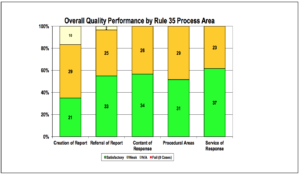- BY CJ McKinney

Rule 35 torture reports kept from lawyers, government analysis suggests
THANKS FOR READING
Older content is locked

A great deal of time and effort goes into producing the information on Free Movement, become a member of Free Movement to get unlimited access to all articles, and much, much more
TAKE FREE MOVEMENT FURTHER
By becoming a member of Free Movement, you not only support the hard-work that goes into maintaining the website, but get access to premium features;
- Single login for personal use
- FREE downloads of Free Movement ebooks
- Access to all Free Movement blog content
- Access to all our online training materials
- Access to our busy forums
- Downloadable CPD certificates
The legal representatives of immigration detainees who claimed to have been tortured or who may otherwise be unsuitable for detention were not given copies of their medical records, internal Home Office analysis shows. This was contrary to the department’s policy.
An audit covering early 2014, but published yesterday, looked at the handling of “Rule 35 reports” written by doctors, mostly when they have concerns about whether a detainee may have been subjected to torture.
These records are the main safeguard against detaining victims of torture or other people unsuitable for detention, such as Alois Dvorzac, the 84-year-old Canadian suffering from dementia who died after a Rule 35 report was ignored in 2013.
In three-quarters of cases, there was no record of the report being sent to the detainee’s lawyer. Likewise, there was no recorded forwarding of the Home Office response to the report in 40% of cases.
The internal Quality Analysis Team found that 82% of Rule 35 cases were correctly decided in terms of whether the person should be kept in detention or not. This is to some extent the Home Office marking its own homework, and even then 18% of decisions were found to be flawed. Either there was no copy of the Rule 35 report on file for the auditors to check (12%) or there were “serious” errors in decision making (6%).
Looking across all the audit criteria – not just the substantive decision on detention – a majority of cases contained at least one “serious” error and were graded as “weak” overall as a result.

Detention services order 09/2016 says that the Home Office is supposed to
forward a copy of the Rule 35 report to the detainee’s legal representative (where a legal representative is recorded on the file).
The audit, by contrast, found that
in 77% (17 out of 22) of cases where the detainee was recorded as having legal representatives at the time of the referral of the Rule 35 report, there was no evidence recorded on CID that the doctor’s Rule 35 report had been forwarded to the legal representatives.
It may be that some of these reports did go to the lawyer without being recorded by the Home Office. The audit notes that, without a record, it is “difficult to defend any claim by detainees and/or their representatives that this has not been done”. Quite.
Officials are supposed to respond to Rule 35 reports within two working days. When the response is issued,
the responsible officer must copy the response to the detainee’s legal representative (if one is recorded on file) at the point of response.
In reality:
In 40% (12 out of 30) of cases where the detainee was recorded as having legal representatives at the time the Rule 35 response was served, there was no evidence that it had been sent to the detainee’s legal representatives.
The analysis goes on:
Again, it may be that in some cases this action was completed, but confirmation of this was not recorded on CID. In some cases there is evidence on CID of this causing a difficulty at a later date, and of phone calls and letters from representatives requesting this information. This can be avoided if the decision is sent to them in a timely manner at the time of response.
It is hard to be sure whether either the procedural or substantive problems are still prevalent. The period covered by the audit was the first quarter of 2014. It may be that the Quality Analysis Team’s recommendations have had the desired effect since then. The Home Office, reasonably enough, stressed to Free Movement that the data is not current. (The audit has been published now, rather out of the blue, because of a commitment made in Parliament.)
That said, only yesterday the Chief Inspector of Prisons released a report on Yarl’s Wood immigration removal centre highlighting “unacceptable delays in the Rule 35 process” and noting that women are being kept in detention despite professional evidence that they have been tortured. If this is anything to go by, Rule 35 reports are still not being dealt with as they should.
